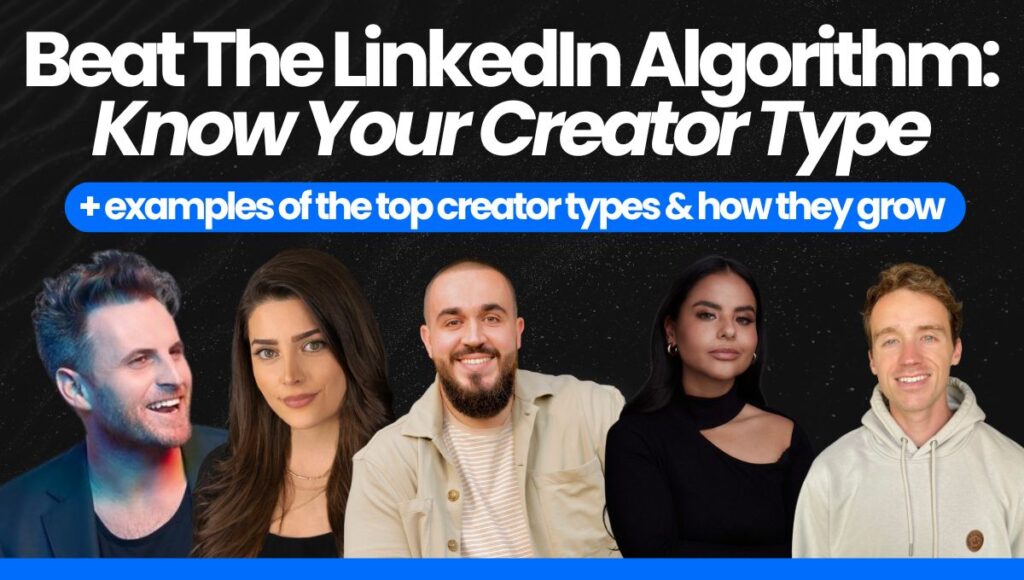It's becoming harder and harder to break through online.
Not only is every platform saturated, but the algorithms are becoming less and less generous with their reach (on top of making it harder for us to take our audience off platform with external links).
Now more than ever it's important to leverage a mix of two different things:
- Our own specific Creator Type and Style
- How it intersects with what works with the algorithms.
Full Disclosure: This deep dive is breaking down LINKEDIN Creator Types and Styles, so don't get confused by my comparison to the Twitter algorithm in this next section.
Alex Garcia of Marketing Examined (Growth Marketing) said this on his interview with Hypefury in 2022:
"If you're trying to grow on a platform specifically, you have to find that platform's growth content. It's the type of content that a platform favors, the algorithm favors, and you focus your strategy all on that content. So like, Twitter, it's Twitter Threads. People know now that you can grow on Twitter really fast writing really good threads.
And he also expanded on this in an interview with Starter Story in August 2023 when asked "How have you been able to grow your newsletter?":
"Being able to find the growth pieces of content that the algorithm favors and will push, and the last year and a half that has been Twitter Threads."
Unfortunately we have missed the boat for Twitter Threads, and X has instead become a place of platitudes and engagement farming - which is why I am all in on LinkedIn in 2024 - but the message still stands, and it's something that we're going to be analyzing in this deep dive.
First things first though:
Does that mean you should go out of your way to strictly create content based on what the algorithm favors?
No. That's where the intersection of what works and your specific content type and style comes into play.
The same way I'm not going to post platitudes and engagement farm on X because it's not my style, and I'm not going to utilize any video tactics that are prominent on certain platforms right now because it's not my style ... I don't expect you to change your preferred Creator Type and Style to adhere to algorithms.
And I wouldn't recommend it, either.
That said, there are things we know about the LinkedIn algorithm, and content styles we can learn from that will help you choose the very best Creator Type and Style specifically for YOU and YOUR content (the same way I did with mine).
We'll be taking a look at creators like:
- Ben Meer
- Jasmin Alić
- Nat Berman
- Sam Browne
- Mike Romaine
- Nathan Baugh
- Jade Bonacolta
And analyzing their Content Type and Style, and how it leverages the LinkedIn algorithm in their favor.
Note: The best deep dive to pair this with would be my Ultimate Guide to Newsletter Types and Styles.
Let's start with what we know about the LinkedIn algorithm:
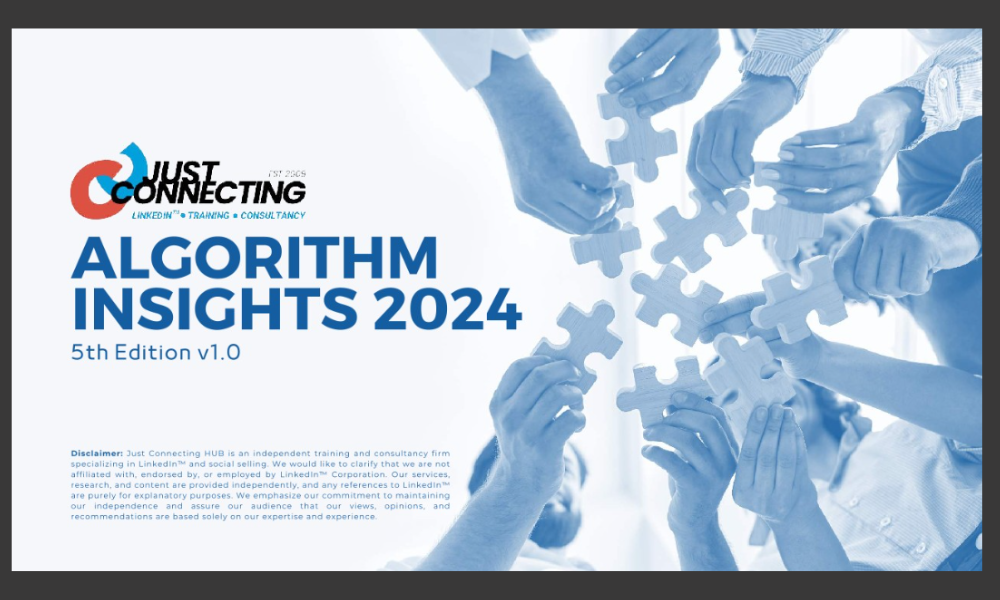
📬What Do We Know About The Linkedin Algorithm?
Thanks to Richard van der Blom, we are lucky enough to have a ton of research handed to us about the LinkedIn algorithm and the type of content it favors.
As of a month ago Richard released his new Algorithm Insights 2024 Report with over 120 pages detailing all the LinkedIn algorithm secrets we need to know to succeed with our content.
Here are a few things I specifically want to point out that will impact our deep dive:
- Polls = 1.62x reach
- Documents (Carousels) = 1.44x reach
- Text + Image Post = 1.27x reach
- Video Post = 1.17x reach
- Text Only Post = 0.90x reach
- External Link = 0.61x reach
- Article = 0.58x reach
Richard gives us a pretty dang good idea of what is working on LinkedIn, and goes even deeper in the full report.
For example, Richard even gives us a full breakdown on how many words to use in our text + image posts (or text only), how many slides to use in our documents (carousels), and so much more.
There are very specific things that are performing best on LinkedIn, and it's our job to make sure we are adhering to those things and optimizing our Creator Types and Style around them.
Please Note: A lot of the creators we'll see in this deep dive likely post other forms of content. As they should [be testing what works]. But I will be mainly referring to what has been their MAIN style and content type to help them grow their audience.

📬#1 - Extremely Broad Content - Carousels and Cheat Sheets: Ben Meer and Jade Bonacolta
Note: Jade Bonacolta learned LinkedIn / audience growth from Ben Meer and used it to grow her LinkedIn following and then expand onto Instagram, so it's obvious why their content and system is so similar - but I am referring to both of them to show you that it works...but runs into the same issue over time.
Both Ben Meer and Jade Bonacolta exploded on LinkedIn (and now even Instagram), with a specific type of content.
- Ben Meer: 566,000 Followers
- Jade Bonacolta: 311,000 Followers
They used what the algorithm favors, and stayed within a specific niche that they knew their [broad] audience favors as well.
Here's how it looks if we take a step back:
- Niche: Extremely broad. Productivity. Performance. Wealth. Systems. Better Life.
- Content Type(s): Carousels and Cheat Sheets
- The Idea: Speak to a broad audience. Post what the algorithm favors. Post what the audience will share the most.
- The Goal: Hyper-fast audience growth.
This is exactly what Ben Meer teaches, and it clearly works.
Here's the only issue some creators may run into:
Because you are in an extremely broad niche it becomes much harder to sell anything other than "how to grow fast like I did", which is what you see Ben and Jade sell with Ben's course/coaching and Jade's coaching.
They also now make sponsorship revenue from their newsletters and are making great money with their offers due to the sheer volume that was able to come from this strategy - but it does come with a negative side (especially if you don't grow as fast and have a hard time selling at all).
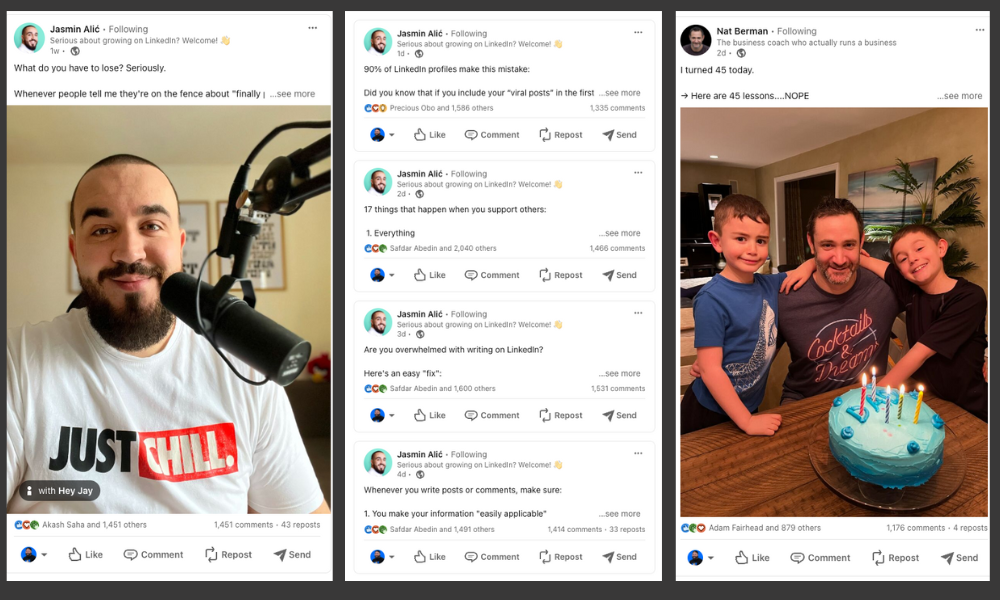
📬#2 - Massive Engagement - Text and Text + Image Posts - Jamin Alic and Nat Berman
I pair these next two creators together because they're both big on engagement and also text + image posts (or in Jay's case, even just plain text posts)!
Jay is is still LOVING regular text posts, even though the algorithm is not favoring them.
This is a pure case of him playing to his style and revolving his methodology around what he loves writing/creating, and also how it plays into the 80/20 Method for him.
He said on a podcast interview with Chris Do that he isn't currently scheduling any of his posts on LinkedIn, and creating text only (or text + AI image [which he admits to on the podcast as well]) could be extremely helpful when creating like this.
I would also say Jay is the King of LinkedIn Engagement.
Jay is an incredible writer, of course, but he also teaches engagement as his number one way to grow on LinkedIn, and has some of the most insane engagement on his own posts as well.
In comparison, Nat Berman, who has around 61,000 followers at the time of writing this (compared to Jay's 195,000) also sticks to his specific style of content and is all in on LinkedIn engagement.
Nat even goes as far as writing:
I want to break down EXACTLY what I do on this platform.
→ I'm on here 6-8 hours a DAY
→ I respond to every single comment
→ And I make a ton of outbound comments
→ This is a choice I make and I own that choice
Yup, you read that right: 6-8 hours a DAY!
Nat is notorious for his text + selfie posts of him wearing a graphic t-shirt, and gets massive amount of engagement on his own posts as well.
Their Creator Type and Style: Text Posts and Text + Selfie Posts.
Their LinkedIn Algorithm Leverage: Hyper-Engagement.
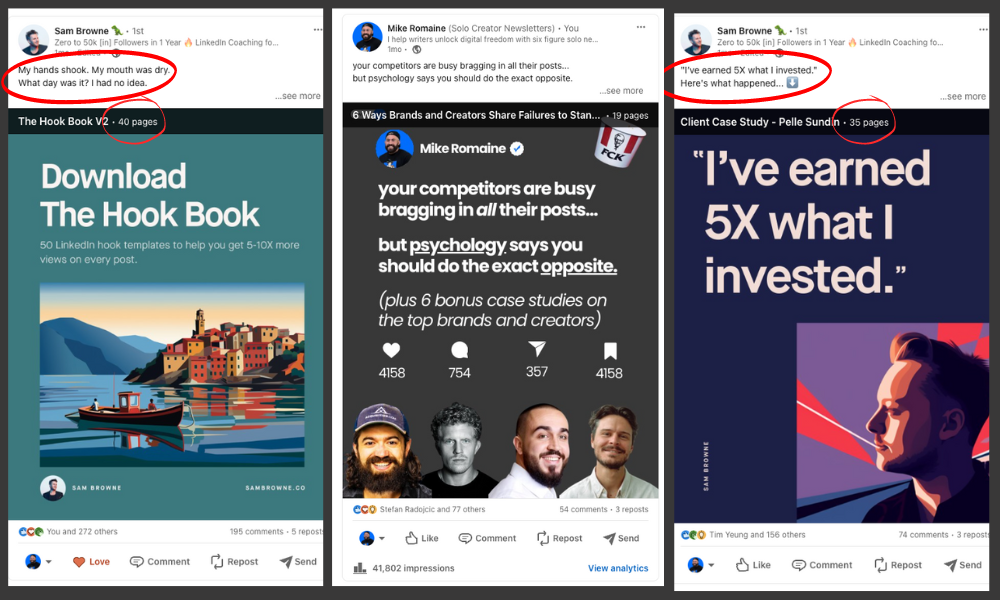
📬#3 - High Value and Depth - Carousels + Stories - Sam Browne and Mike Romaine (Me)
Let me just start by saying that I am in no way trying to compare myself to Sam Browne and his incredible LinkedIn growth.
That said, I figured if I was going to highlight a creator that is smaller but currently growing even while starting after the LinkedIn algorithm changes...
Who better to highlight that with than myself?
I have grown hundreds of thousands of subscribers across multiple YouTube channels, over 100K+ across TikTok channels, millions of newsletter subscribers, and tens of thousands on platforms like Facebook and Instagram.
I started taking LinkedIn seriously in January of this year, after growing to around 2,000 on Twitter and realizing the direction it was going - and now I'm nearing 3,000 followers on LinkedIn and all in for 2024.
Sam Browne is at about 100,000 followers, and gained 50,000 of them in one year.
So just a small difference in growth...
That said, I wanted to highlight both of us together because we both like using longer, high value carousels as our preferred Creator Type and Style, but we do it in different ways.
Sam is an incredible storyteller and uses this strength to tell stories while delivering insane amount of values in carousels that are upwards of 50+ slides.
While this may not be AS impactful with the LinkedIn algorithm anymore, this was what brought Sam his massive growth.
Note: Sam is a pro and aware of these algorithm changes so [more recently] you'll see him leveraging shorter carousels 15-20 slides, and text + image posts, while still leveraging his powerful storytelling.
Where Sam is a storyteller, I am more of a researcher, and I utilize case studies and video lessons to deliver high value carousels breaking down lessons similar to what we are doing right here in this deep dive.
Knowing the type of creator I am, but also knowing the impact of story for my brand, I am also intentional about using 1-2 text + image posts per week to inject my own personal stories into my content. This may not be as great for reach, but it does a lot for my branding and connection to my audience.
I'd argue Sam is in a better position than I am if carousel reach were to die down even more over time (it was previously even higher, closer to 2.2x reach), considering his knack for storytelling - but at the moment, we are taking advantage of our specific Creator Type and Style.
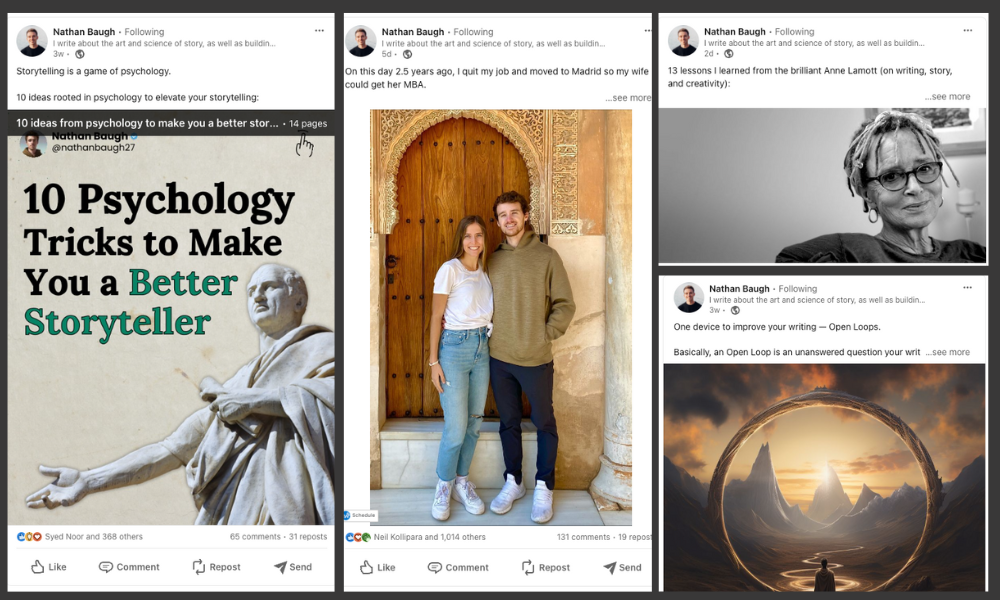
📬#4 - Niche Specificity - Hybrid Content - Nathan Baugh
Nathan Baugh is getting a category of his own in this one because he's my favorite example of a creator that has his very specific niche, but does an incredible job at creating hybrid content that allows him to teach, research, tell stories, inject himself into the brand to make it personal and more.
Nathan's niche is storytelling, so it would be easy for a creator to think they should JUST tell stories, but Nathan instead teaches lessons from other storytellers (while borrowing their authority), tells his own stories, and also teaches tons of other lessons, all tied back to making us better storytellers and writers.
Nathan note only knows his Creator Type and Style, but he also is very clear on his niche AND how to leverage what is working with algorithms.
He originally blew up on Twitter leveraging threads (like we saw Alex Garcia discussing at the beginning of this article), but now you can find him using all different types of posts on LinkedIn (almost always leveraging carousels and text + image posts, which are LinkedIns highest performing post types).
- Niche: Storytelling - Very Specific
- Creator Type: Carousels and Image + Text
- Content Style(s): Stories + Research + Lessons
Similar to how I think a hybrid style is your best bet for finding your Newsletter Business Model, I also think a hybrid style of content creation is great for honing in on what works best for you and how it intersects with the algorithm(s).
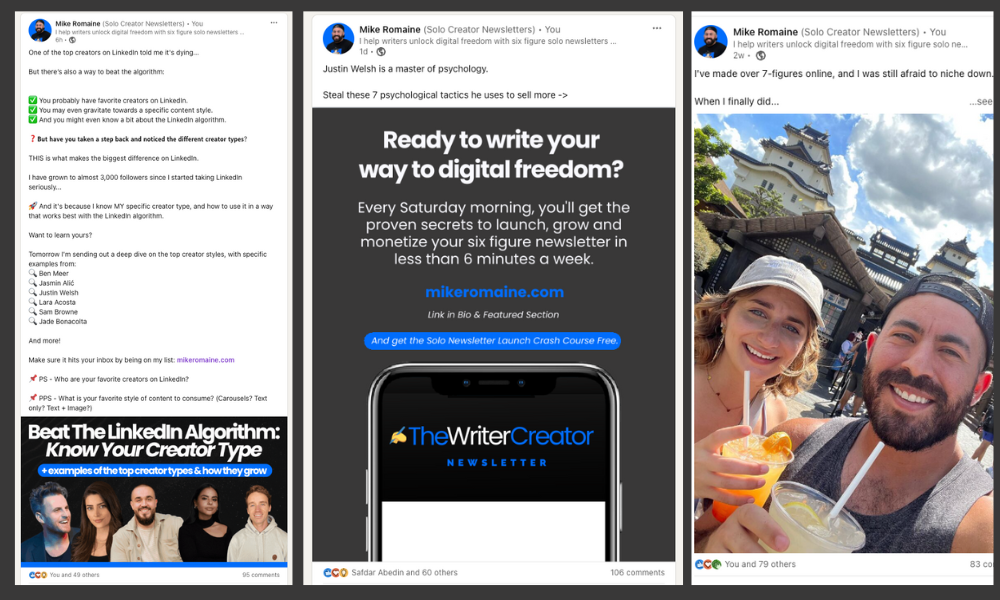
📬BONUS: Leveraging Your Creator Type and Style with Newsletter Growth Tactics
Another great reason to be aware of your specific Creator Type and Style is to leverage it with newsletter growth tactics.
With platforms making it harder and harder for us to use external links and drive our audience off the platform without being penalized; it's more important than ever to know the tactics that work best for our specific style.
Here are some big examples that pertain to my specific Creator Type and Style:
- As you can see [in the image] above, I leverage a call to action at the end of each of my carousels, letting my audience know they can subscribe to my newsletter for more awesome content.
- Being that I leverage carousels more often than I use text + image posts, it's harder for me to use link injections in my content without being penalized (there is less of a penalty if you add an external link after an hour of posting, as long as you're not editing more than 15% of the post).
- Because of this, I make a specific point to use teaser posts with direct link call to actions (aware that I'll be penalized for adding them right away, but know it's worth the trade-off for subscriber growth) the day before every newsletter.
You can find a few more of these growth tactics in my article on The Top 3 Ways To Grow Your Newsletter.
So, knowing your Creator Type and Style allows you to learn to take advantage of tactics that work best for it.
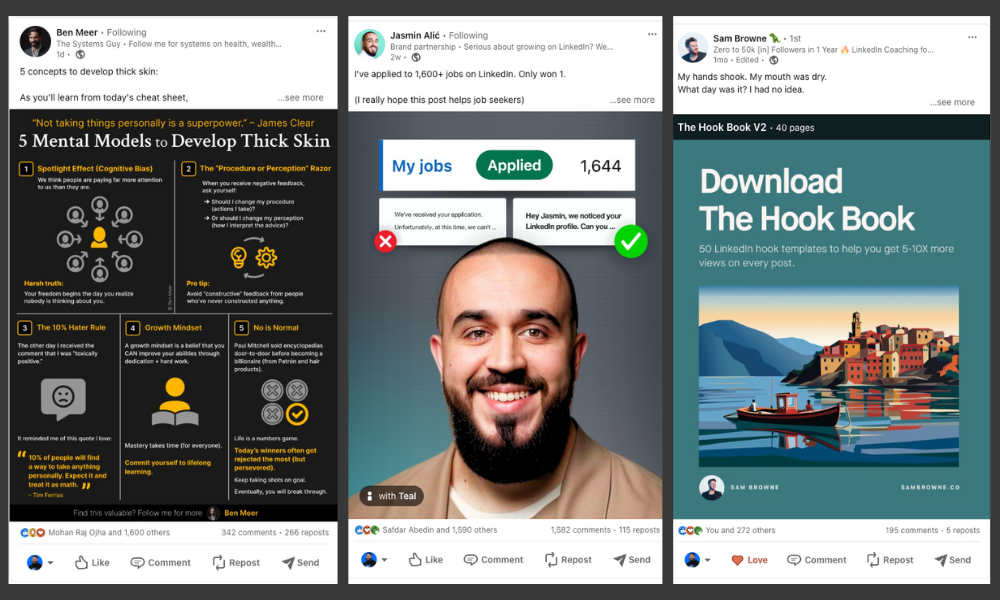
📬 Find Your Content Type And Style with The 80/20 Method
The 80/20 Method, also known as The Pareto Principle is likely going to play a big factor in how you find your specific Content Type and Style.
And it plays a role in not just LinkedIn, but also figuring out if what platform you should be optimizing for in general...
If you're new to the Pareto Principle it's described like this by Wikipedia:
The Pareto principle (also known as the 80/20 rule, the law of the vital few and the principle of factor sparsity) states that for many outcomes, roughly 80% of consequences come from 20% of causes (the "vital few").
In The Four Hour Workweek Tim Ferriss described the realization that 80% of his income was coming from 20% of his business accounts, therefore meaning that he was doing 80% more work, for a mere 20% more income...
He trimmed 20% of that income, which were making up the customers that were spending less, but taking up more work (complaints, problem customers, etc.) and was able to continue generating 80%, while only working a mere 20% of the time.
This can also be tied back to your Creator Type and Style.
Here's an example comparing me and my younger brother (we grew him to over 100K+ followers across TikTok, IG/FB last year, and he now makes 50k/m with his agency):
- I prefer writing and selling digital products. If you asked me to create video content and be on coaching calls all day, I'd be exhausted and miserable. But writing and researching is the stuff that gets me skipping out of bed in the morning.
- My brother hates writing, researching and building out funnels and products. But he thrives with short form video and working directly with clients (coaching and consulting). If he had to write content everyday he'd be miserable. But creating video content and working with clients gets him skipping out of bed in the morning.
Can you see the difference?
So I'm not telling you that you should find the platform that is most rewarding and go create content on it, or to create content you hate just because it's being rewarded.
If that were the case I'd still be on Twitter and I'd have to post engagement bait and platitudes all day long.
Instead I'm telling you to be aware of the content that the algorithms reward and while knowing your specific style, adapt your Creator Style to it.
Here's another quick example for you:
- If Twitter Threads were still performing as they were a year or so ago, they would be the perfect place for my style of research based value content.
- Carousels are the best style for me. But if they were to dip in reach to the point where they no longer made sense to create (they take FAR longer than writing a text + image post), I still really enjoy writing longer form valuable content and stories, and would shift to doing that far more often.
- If I was to switch to posts that are quicker, then it may be smart for me to use that extra time I have every single day to engage more like Jay and Nat.
Why it's even more important on LinkedIn to know your Creator Type and Style, and how it intersects with the algorithm:
We get one shot per day to make an impact on our audience (and potential audience) on LinkedIn.
Any posts after the initial post [per 24 hours] will impact the reach of each post after.
This makes it even more important to be aware of your specific Creator Type and Style, so you can actively make changes to the way you create to impact the way the algorithm favors your content.
How To Beat The LinkedIn Algorithm:
- Know Your Creator Type and Style
- Know What The LinkedIn Algorithm Favors
- Know Where Those Two Things Intersect
- Show Up Every Single Day Looking To Improve

